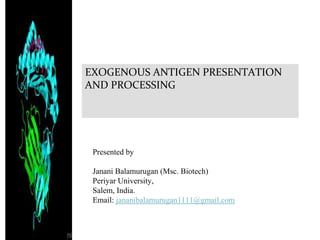
Exogenous Antigen Presentation and Processing.pptx
- 1. EXOGENOUS ANTIGEN PRESENTATION AND PROCESSING Presented by Janani Balamurugan (Msc. Biotech) Periyar University, Salem, India. Email: jananibalamurugan1111@gmail.com
- 2. Antigen presentation and processing
- 3. What is Antigen? • Antigen – Any foreign agents that binds to TCR or Antibody. • Immunogen – inducing humoral or cell mediated immune response. • highly requires the foreigness of the agent.
- 4. Introduction • In order to engaging the key elements of adaptive immunity - antigens have to be processed and presented to immune cells. • This was recognized by 2 highly different receptor molecule - Antibodies or B cell receptor and T – cell receptor. • Antigen presentation is mediated by Protein called Major histocompatibility complex (MHC) molecule. B - cell receptor T – cell receptor Recognize Antigen only Recognize pieces of antigen.
- 5. Definition – Antigen presentation and processing Antigen processing • The mechanism protein antigen degraded into peptides and attaches to the binding groove of different MHC molecules known Antigen processing. • Different types of MHC (Class I and II) determines the different types of pathway. Antigen presentation • The appearance of these Peptite - MHC (pMHC) complexes on the cell surface for the recognition of T- cell receptor known Antigen presentation.
- 6. Types - Antigen presentation and processing pathway Classified into two types based on • Antigen originating from the different compartments are delivered to the cell surface by different classes of MHC molecule. 2 TYPES • Endogenous pathway – takes up intracellular antigens • Exogenous pathway – takes up extracellular antigens.
- 7. Table demonstrating the difference between the 2 pathways and the molecule that involved in it.
- 9. characters ENDOGENOUS PATHWAY EXOGENOUS PATHWAY Source of Antigen Antigen peptide originating from cytosol. Eg: self-protein antigens (e.g. tumor antigens) and non-self protein antigens (e.g. viral antigens) Antigen peptide originates in vesicular system. Eg: bacterial, viral, protozoa, fungal and parasitic antigens. Presented to Co receptor of CD8 of TC cells. Co receptor of CD4 of TH1 cells and Tc cells. Effect on presenting cell Cell death Activation to kill intravascular bacteria and parasites / activation of B cell to secrete Ig to eliminate bacteria or toxins. Degradation Cytosol proteases Endocytic vesicle (low pH) Transporting molecule TAP Invariant chain (Ii), HLA-DM
- 10. Exogenous presentation pathway INTERNALIZATION OF ANTIGEN PROTEIN BY ENDOCYTIC PATHWAY • The extracellular proteins are internalized by Phagocytosis/ receptor mediated endocytosis / pinocytosis. (1-3 hours). • Once internalization occurs – endocytic processing pathway turns on (Endosome contains – acid proteases – cathepsins B,D,S, and L among these L is most active.) • This pathway takes antigen to several compartments with lowering pH which activated hydrolytic enzymes.
- 11. Exogenous presentation pathway • 1st to early endosome (pH 6.0 – 6.5) • 2nd late endolysosome (pH 4.5 – 5.0) (also by phagolysosome) • 3rd to lysosome (pH – 4.5) • Finally the APCs has unique compartment – MIIC (MHC Class II containing compartment) , where the final degradation and protein loading (13 – 18 A.A) occurs. • INHIBITOR – Chloroquine
- 12. The late endocytic pathway, occurs with phagosome/ endosome + lyzosome = phagolysosome/ endolysosome. PRR binds and recognize PAMP – opsinization triggers phagocytosis Phagosome + lysosome activates specific granules that lowers the pH and kills few antigen. Certain other granules (Azurophilic) – kills and activates the inactive proteases and degrades remaining antigen. Exogenous presentation pathway
- 13. Exogenous presentation pathway How Invariant chain directs the MHC Class II to MIIC compartment? • APCs contain both MHC Class I and Class II mol. • The MHC class II has opened groove at both ends this sometimes binded with the antigenic peptide designed for MHC Class I molecule. • So, this could be prevented by the Invariant chain (Ii, CD74) this binds to the binding groove of MHC Class II mol. • And this Ii, CD74 directs the MHC class II from the RER, Trans – golgi network to the Endocytic processing pathway.
- 15. • In the RER, the unfold MHC class II present along Invariant chain and transport to the acidified endocytic vesicle through Trans - golgi networks . • This cleaves the invariant chain into small fragments called CLIP (Class II associated invariant- chain peptide) in first panel. • 2nd panel - Now the CLIP bounds to the binding groove of MHC Class II. • 3rd panel, the pathogen peptides are unable to bind to the CLIP – MHC Class II complex. • 4th pannel, the class II like HLA-DM binds to the MHC class II – CLIP complex, catalyzing the release of CLIP and binding of antigenic peptide. Exogenous presentation pathway
- 16. Processing of antigenic peptides to the plasma membrane by MHC molecules. • Once the peptide has bound, the class II MHC-Peptide complex is transported to the plasma membrane where the pH is neutral. • Thus, the complex is compact and stable form. • It is difficult to replace with another peptide at physiological condition. Exogenous presentation pathway
- 17. Diagramatic representation of Exogenous pathway REFFERENCE: 1.Janeway’s immunobiology – 8th edition – 6th chapter – pg.no: 201 – 214 2. Kuby immunology – 7th edition – 8th chapter – pg.no: 261 - 291
- 18. THANK YOU
